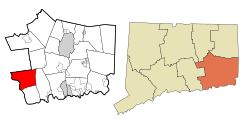Lyme | |
|---|---|
| Town of Lyme | |
 First Congregational Church | |
| Coordinates: 41°24′N72°21′W / 41.400°N 72.350°W | |
| Country | |
| U.S. state | |
| County | New London |
| Region | Lower CT River Valley |
| Settled | 1645 |
| Incorporated | February 13, 1667 |
| Government | |
| • Type | Selectman-town meeting |
| • First selectman | David Lahm (R) |
| Area | |
• Total | 34.5 sq mi (89.4 km2) |
| • Land | 31.9 sq mi (82.5 km2) |
| • Water | 2.6 sq mi (6.8 km2) |
| Elevation | 26 ft (8 m) |
| Population (2020) [1] | |
• Total | 2,352 |
| • Density | 68/sq mi (26/km2) |
| Time zone | UTC-5 (Eastern) |
| • Summer (DST) | UTC-4 (Eastern) |
| ZIP code | 06371 (Old Lyme PO) and 06439 (Hadlyme PO) |
| Area codes | 860/959 |
| FIPS code | 09-44210 |
| GNIS feature ID | 0213453 |
| Website | townlyme |
Lyme is a town in New London County, Connecticut, United States, situated on the eastern side of the Connecticut River. The town is part of the Lower Connecticut River Valley Planning Region. The population was 2,352 at the 2020 census. [1] Lyme is the eponym of Lyme disease. [2]
Contents
- History
- Geography
- Principal communities
- Principal bodies of water
- Demographics
- 2010 and 2020 censuses
- Voter registration
- Ancestry/Ethnicity
- Public facilities
- Civic and fraternal
- Governmental
- Religious
- Points of interest
- State parks and forests
- On the National Register of Historic Places
- Public transportation
- Lyme in literature, art, and film
- Notable people
- References
- External links










